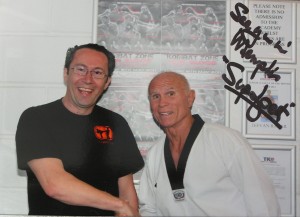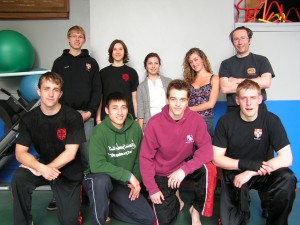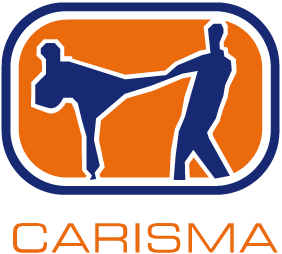 I had the opportunity of taking part to a seminar and training with Bill “Superfoot” Wallace earlier today: a truly amazing experience. Please read the blog post in my Martial What? blog if you want to know more, just clink on the picture.
I had the opportunity of taking part to a seminar and training with Bill “Superfoot” Wallace earlier today: a truly amazing experience. Please read the blog post in my Martial What? blog if you want to know more, just clink on the picture.
Author Archives: Massimo Gaetani
Xmas Dinner 2010
Last year’s Xmas Dinner seems like yesterday: it may come as a surprise that not only is the next grading on Sunday, December 5th, but it is to be followed by the time-honoured tradition of the Carisma Xmas Dinner.
This year’s dinner will take place at the CB2 Bistro, on 1 Norfolk Street. We have reserved a private room just for us.
Places are available now, for the princely sum of £18.95 (drinks are charged separately on the day). We’ll be taking names & collecting a non refundable deposit at all training sessions until Thursday 3 December.
To use a sentence used last year by Wez: this is a once-a-year opportunity to change the colour of your belt twice in one day – once in recognition of the effort and commitment you have put into training with Carisma, and once in recognition of the vibrantly coloured food you have spilled down yourself.
Learn Stretching from the Master
Bill “superfoot” Wallace retired in the early eighties as undefeated world champion in the middle weight of full contact kickboxing: his combat strategy was always based on fantastic kicking techniques that often caught by surprise his opponents and knock them out. Wallace was not just good and superfast in kicking but he could shoot double of triple kicks with a single leg, using these techniques in the same way most boxers faint punching techniques.
Apart from his obviously amazing experience as a martial artist Wallace has a master in Sport Science that further qualifies him to advise people about stretching for flexibility. He was a true precursor of innovative stretching excercises and applications like the one decribed in the video below.
It shows here how to improve flexibility for side kicks (and it equally applies to round and hook ones): good news is that we at CARISMA regularly do a very similar (simplified) version during our classes, so it’s good to learn the extra movements we can add.
Varsity 2010: winners!

(l-r) font row: the winning team Chris Kelly, Chris Webb, Frank Gorringe and Alex Howard; back row: Sam Goldschneider (vice president), Heley Matthews (captain), Veronika Kantorivich (social organiser), Heidi Holmes (president) and Massimo Gaetani (coach)
Cambridge University Kickboxing Society won yesterday the 4th Kickboxing Varsity match vs. Oxford University Kickboxing Club for a final result of 3-1!
This was a much suffered event: until Thurs it was unsure whether we would have had an event at all and where. When OUKC nearly gave up we managed to put together a last minute venue, get the referee to leave his family at a holiday location to come and ref the fights and even invited about 30 spectators…but it was all worth the effort.
When in 2007 the CUKBS committee at that time asked me to become their coach they put it in simple terms: “we want to win Varsity”; it was hard work, lots of sweat, it wasn’t just about teaching techniques (that’s easy) it was matter of changing completely the way they practice. After an encouraging 4-5 loss last year I can now finally say: “mission accomplished :-)”
More details, videos and so on will follow in the next few days.
CARISMA Town vs. Gown 2010 – Massimo’s summary
 The first CARISMA Town vs. Gown that took place yesterday at the Manor Community College in Cambridge was a great success. It surely exceeded my own expectations as well as the ones of all people that took part to it, among fighters, organisers or spectators.
The first CARISMA Town vs. Gown that took place yesterday at the Manor Community College in Cambridge was a great success. It surely exceeded my own expectations as well as the ones of all people that took part to it, among fighters, organisers or spectators.
It all started from a simple idea about offering the possibility for beginners and first timers to experience fighting in the ring while in a friendly environment. I truly feel it could have not gone much better as we had:
- Over 170 people watching and supporting
- A great team of over a dozen organisers that ensured a smooth running of the event between door access, coaching, photography, presenting, DJ and entertainment and medical assistance that luckily was not needed.
- 29 fighters that delivered 15 top class fights and a great show: please notice that 18 of them were at their first fighting experience and 9 of them started training kickboxing in October 2009 with no previous experience in martial arts!
I did a lot of thinking during the last couple of days, between the amazing rush to get everything done on time and last night when I was as tired as if I took part in every single bout and yet I could not sleep because of the adrenaline released… Here are a few random considerations about the whole event:
- Although each fighter was a student of mine I was surprised about how competitive I felt for the person I was coaching: funny enough several times I found myself giving suggestions to the other fighter as well;
- Many of the spectators were members of the three clubs and several of them pointed out how great the whole thing was and how they could have not never seen themselves in the ring and fighting. In many cases I replied: “if you want to you can do it, it’s just matter of planning it and training for it”.
- One of the greatest achievements of the whole day was having no accidents, giving no work at all to Soren, the medical officer who managed to even spend some time coaching some of the CUKBS fighters.
- The role of a coach is key for the good result of a fight because it offers an extra pair of eyes with a much broader vision as well as a fairly detached view of the fight, not (too much) affected by adrenaline and other chemicals;
- At the same time the role of the coach is highly facilitated by a fighter that can listen and simply put in practice the strategies suggested by the coach;
- Learning how to fight is part of learning kickboxing. We usually invite people to sparring classes as soon as they are fit for it simply because techniques must be put in practice in a dynamic environment where your partner/opponent is no longer collaborating and helping you. The next step is fighting in a competition, even a friendly one like this one brings you to the next level, fighting to win or be beaten and a lot of emotions kick in, some people can manage them well while for other it is just overwhelming.
- Managing energy across the fight is a skill to be learnt and put in practice. Most of yesterday’s fighters are regularly attending to sparring classes where every Monday we run 14-15 rounds of 2 and half minutes: nonetheless we saw energy simply running out for a few people. Often it’s not due to lack of fitness but the emotional involvement in the fight that is draining up all energies.
- Behind a great organisation there is always a great management team: instructors and committee of CARISMA yesterday demonstrated this by ensuring the whole event running perfectly and covering all roles and tasks that were required. Ditto for the committees of CUKBS and ARUKBC that offered help in key logistic areas.
- Although I am no stranger to public speaking it was the first time I felt at the centre of the show in the way I was yesterday: standing on a stage with a microphone and talking to so many spectators seems easy but it surely requires a bit of training and practice. Using a well known slogan from a Mastercard advert: having my 6 years old daughter shouting “I am so proud of my dad: is famous because he is speaking on the stage” was absolutely priceless 🙂
I would like to thank, personally and on behalf of a very successful Town vs. Gown 2010, in random order:
- Judging and refereeing: Pete, Luis, Mark Taylor, Jill, James Bush
- Assistance and supervision on lights and audio: Georgios
- DJ and entertainment: Rhemayo
- Photography: Duncan and Mark Nicmanis
- Coaching: Soren, Robin, Heley, James Bush
- Door and security: Andrea, Veronika and Sam
- Medical assistance: Soren
- Speaker and presenter: Wez
- Round boards girl (can’t think of a better definition at the moment): Veronika
- Fighters: Jill Sommerville, Harriet Teare, Heidi Holmes, Helen Porte, Lucy Liu, Jenny Almeida, Ronnit Wilmersdoerffer, Heley Matthews, Marie Fygle, Rosie Snajdr, Amin Abolghasemi, Nasser Salmi, Jeremy Leong, Vassil Richter, Aaron Lewis, Alexandre Larose, Franz Ronay, Andrew Gilham, Phil Mcdiarmid, Jamie Trotman, James Leggett, Richard Blockley, Tom Hennessy, Chris Kelly, Chris Jones, Neil Levesley, James Bush, Georgios Evangelinos
Results, pictures and videos of the show will be available as the various people involved will be in the position to supply them: just keep following the TG2010 tag on this blog for any further development.
If you were there I would like to know your impressions: please leave a comment to this post.

